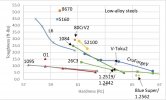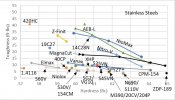I usually see fixed blades, especially bushcraft style or similar outdoor use, in steels like A2, 01,1095, etc.
My understanding is that there are several stainless steels (14C28N, AEB-L, 420HC, LC200N) that are equal or superior in terms of toughness and edge retention, in addition to being stainless.
So my question is why aren't more outdoor use fixed blades offered in stainless?
Thanks.
My understanding is that there are several stainless steels (14C28N, AEB-L, 420HC, LC200N) that are equal or superior in terms of toughness and edge retention, in addition to being stainless.
So my question is why aren't more outdoor use fixed blades offered in stainless?
Thanks.



